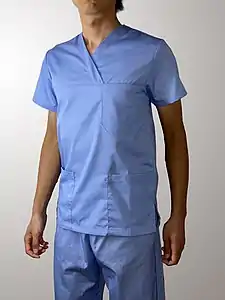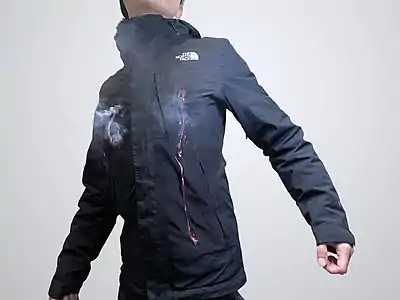
| Part of a series on |
| Costume |
|---|
 |
Stage clothes worn by actors who portray characters that are shot and wounded in movies, TV shows, or theatre productions are modified to conceal special effects equipment such as squibs, wires and controllers are commonly referred to as "dead-character costumes".[1] These costumes are a crucial element to create a captivating and dramatic scene. Typically, several identical sets of these costumes are prepared for the planned number of takes as "consumables" and are used only once. After use, they are placed on the "dead-character rack" and not reused, unlike other clothing articles that return to the costume shop.
In the main figure, the actor wears one of several identical dead-character costumes prepared with bullet hit squibs to simulate gunshot wounds for a movie scene.
Costumes used for bullet hit squibs
A bullet hit squib device creates the illusion of an actor being shot and wounded by bursting a small fake blood packet hidden beneath their costume, which serves as a canvas for the special effect and enables the audience to see the simulated injury in real-time. Clothing is used to conceal the device, and precut bullet holes are made in the fabric before attaching the squibs. Costume selection should consider script requirements, squib integrability, aesthetics, and budget. Typically, 3[2]-6[3] identical stunt pieces with prescored bullet holes and squibs, and one hero piece without squibs for close-ups and prior scenes, are prepared for the planned takes, schedule, rehearsals, backups and tests. Having extra pieces on hand helps ensure smooth execution. The outfit's colour should be bright or have sufficient set lighting to show bloodstains,[4] as shown in the example of the light blue scrubs used here.
- Example of identical sets of scrubs used for a movie scene
 The non-modified hero piece, for use in most scenes where the character appears.
The non-modified hero piece, for use in most scenes where the character appears..jpg.webp) The stunt piece for the gunshot scene with 6x embedded squibs, each containing 15 g of fake blood showing a minor bulge on the fabric.
The stunt piece for the gunshot scene with 6x embedded squibs, each containing 15 g of fake blood showing a minor bulge on the fabric..jpg.webp) The second stunt piece after the scene with exposed "bullet holes" and fake blood.
The second stunt piece after the scene with exposed "bullet holes" and fake blood..jpg.webp) The second stunt piece after laundering, showing holes left by the squibs.
The second stunt piece after laundering, showing holes left by the squibs.
Preparation of the costume
Bullet holes (~50 mm diameter) are determined by number, sequence, and location. Fabric must be weakened (often by legislation) by cutting,[5] sanding,[3] scoring,[6] grating[7] or plunging a scoring tool,[8] before being glued or taped back together to maintain an intact appearance from a distance. A semi-scored fabric helps create a frayed hole aesthetic.[9]
The squib assembly, being relatively large and heavy, is attached securely[3][10] on the inside of the outfit to ensure the fake blood is propelled outwards. Inner lining and filling are removed to access the site and reduce thickness and bulge.[11]
A well-made, low-profile squib device should not be conspicuous, and pre-scoring should be subtle. Any visible bullet holes also can be erased in post-production.[12][13] For jackets with multiple frontal squibs, an additional back zip may be installed by the costumer for ease of dressing.[14] All zips and buttons should be fastened for visual and safety purposes to prevent recoil, accidentally revealing the squibs or aiming in unintended directions.
- Preparation of a dead character costume for bullet hit squibs
 6x identical jackets (albeit different colours) are budgeted for a movie scene with bullet hit squibs.
6x identical jackets (albeit different colours) are budgeted for a movie scene with bullet hit squibs. Bullet hit locations marked out with white stickers. The trigger sequence and the camera angles should also be determined. A completed squib is placed temporarily on the costume for reference.
Bullet hit locations marked out with white stickers. The trigger sequence and the camera angles should also be determined. A completed squib is placed temporarily on the costume for reference. The inner taffeta lining cut open, exposing the outermost fabric from the inside which is then scored with a blade. The squib device is then aligned to the hole and attached with duct tape.
The inner taffeta lining cut open, exposing the outermost fabric from the inside which is then scored with a blade. The squib device is then aligned to the hole and attached with duct tape. An actor points to and checks the embedded bullet hit squibs are secure in his jacket.
An actor points to and checks the embedded bullet hit squibs are secure in his jacket.
Reusing dead-character costumes
To create a convincing bullet hit squib effect, a significant wardrobe budget is required as most types of clothing can only be used once per take. Jackets (e.g. waterproof, parka and down) are a cost-effective wardrobe choice as they can be reused and also offer versatility, concealment and comfort. They adapt to various characters and settings, provide a more sophisticated appearance and a higher production value, easily hide multiple squibs and wiring, are comfortable for extended filming or performing periods, and can be wiped clean and reset for multiple takes. Down jackets should have their filling repacked in a taffeta pocket for preservation of the puffy aesthetic. Using dry or non-staining simulants like water [15] during rehearsals also eliminates staining. Jackets provide a flexible, practical solution for enhancing bullet hit squib effects in movies and theater productions.
- Bullet hit squibs on a waterproof down jacket
 The hero jacket without any modifications to be used for all scenes except when the actor is "shot".
The hero jacket without any modifications to be used for all scenes except when the actor is "shot"..jpg.webp) The first stunt jacket with 6x bullet hit squibs (labelled) embedded. Each squib contains 25 g of fake blood with a modest bulge on a dark fabric.
The first stunt jacket with 6x bullet hit squibs (labelled) embedded. Each squib contains 25 g of fake blood with a modest bulge on a dark fabric. The second stunt piece with 2x squibs set off for a demonstration.
The second stunt piece with 2x squibs set off for a demonstration.
When costumes cannot be altered or damaged, realistic blood stains can be created using painted nylon tulle mesh with an acrylic top coat[16] and added ripped fabric for bullet holes. This method allows repositioning before sewing and removal after production for costume reuse. However, it does not replicate the blood spray effect of a bullet hit squib, potentially requiring CGI to achieve that effect.
Performing with bullet hit squibs
Squibs in special effects are connected to a trigger, power source, and sometimes a programmable controller for synchronising multiple squibs.[3] The stunt costume is bulkier and heavier than the hero version, requiring care when dressing to avoid damaging the squibs. Actors can change into the prepared outfit right before the shot, during a scene, or wear it all day. A two-step ignition procedure is used to prevent accidental triggering,[5] i.e., a switch with the actor and crew, where both switches need to be on before ignition is possible. Here, an actor is shown preparing for the scene by checking the squibs are secure on his costume and performing a test-fire sequence.
Spent and unspent costumes are kept until post-production is complete for potential extra footage.[17] Afterwards, they can become souvenirs, auctioned memorabilia, repaired, or donated, especially with high-quality winter coats.[1]
Further examples costumes used in tv/film with bullet hit squibs
In the Sara (1997 film) example, one hero down jacket (frame 1) and two stunt pieces (frames 2-4 and 5-6) were used for the down jacket. Slight misalignment of gunshot wounds on the chest is visible between the two stunt jackets. The first stunt jacket likely underwent several takes, with the bullet hole visible in frame 2 and refilled down feathers in frame 4. The second stunt jacket was used in frames 5-6, with a precut + shaped bullet hole seen in frame 5 before bursting in frame 6. This is also one of the few instances of using down feathers to achieve the gunshot wound aesthetic on a down jacket.

_34.jpg.webp) Fired squibs on a shirt worn during the death of a character in an episode of the US police drama NCIS
Fired squibs on a shirt worn during the death of a character in an episode of the US police drama NCIS
See also
References
- 1 2 Nirode, Vanessa (16 March 2018). "The Afterlife of Movie Wardrobes". Racked. Retrieved 17 August 2021.
- ↑ dontshootthecostumer (14 April 2013). "B IS FOR…". Don't Shoot the Costumer. Retrieved 6 February 2021.
- 1 2 3 4 Kawin, Bruce F. (1992). How movies work. Berkeley: University of California Press. p. 358. ISBN 0-520-07696-6. OCLC 23976303.
- ↑ Gill, Liz (2012). Running the Show: The Essential Guide to Being a First Assistant Director. Taylor & Francis. p. 72. ISBN 9780240821467.
- 1 2 Special effect pyrotechnics manual. Canada. Natural Resources Canada (Edition 3, 2014 ed.). [Ottawa]. 2014. ISBN 978-1-100-23070-2. OCLC 901995371.
{{cite book}}: CS1 maint: location missing publisher (link) CS1 maint: others (link) - ↑ "The Hit Kit – Bullet Hit Squib Kit for Professional Pyrotechnicians". Roger George Special Effects. Retrieved 6 February 2021.
- ↑ "How to blow up a car (in the movies)". BBC News. Retrieved 6 February 2021.
- ↑ Hit Kit Squib Bullet Hit – For Professional Pyrotechnicians ONLY, retrieved 17 August 2021
- ↑ Street Kings: What Are Squibs?, retrieved 1 January 2022
- ↑ The Vetala – Squibs, Stunts, and Bullet Hits, retrieved 14 March 2021
- ↑ "Working with Blood on Costumes". ProductionHUB.com. Retrieved 6 February 2021.
- ↑ Gallina, Michelle. "Java Post Adds to its Invisible Effects Toolbox with Content-Aware Fill in Adobe After Effects". Adobe Blog. Retrieved 9 December 2022.
- ↑ chinfat (29 May 2014), Gun Squib Tutorial Part 1- How to Make Gun shot Bullet Hit for Indie Movies, retrieved 13 November 2021 – via Youtube
- ↑ "Colonel Claus von Stauffenberg (Tom Cruise) Firing Squad Uniform Wardrobe from Valkyrie (2008) @ Online Movie Memorabilia Archive and Marketplace - PROPbay.com". www.propbay.com. Retrieved 13 November 2021.
- ↑ Duerr, Seth; Kirby, Jared (2021). Staging Shakespeare's Violence: My Cue to Fight: Domestic Fury. Pen and Sword History. p. 276. ISBN 978-1526762436.
- ↑ Knott, Jenny. "Avoid "Pink Shirt Syndrome!" Learn How To Make Convincing Bloody Costumes That Won't Stain Everything Else - Rosco Spectrum". www.rosco.com. Retrieved 30 December 2021.
- ↑ Parker, Ryan (14 July 2017). "'RoboCop' Actor's X-Rated Death Wasn't Gory Enough For Paul Verhoeven". The Hollywood Reporter. Retrieved 17 August 2021.